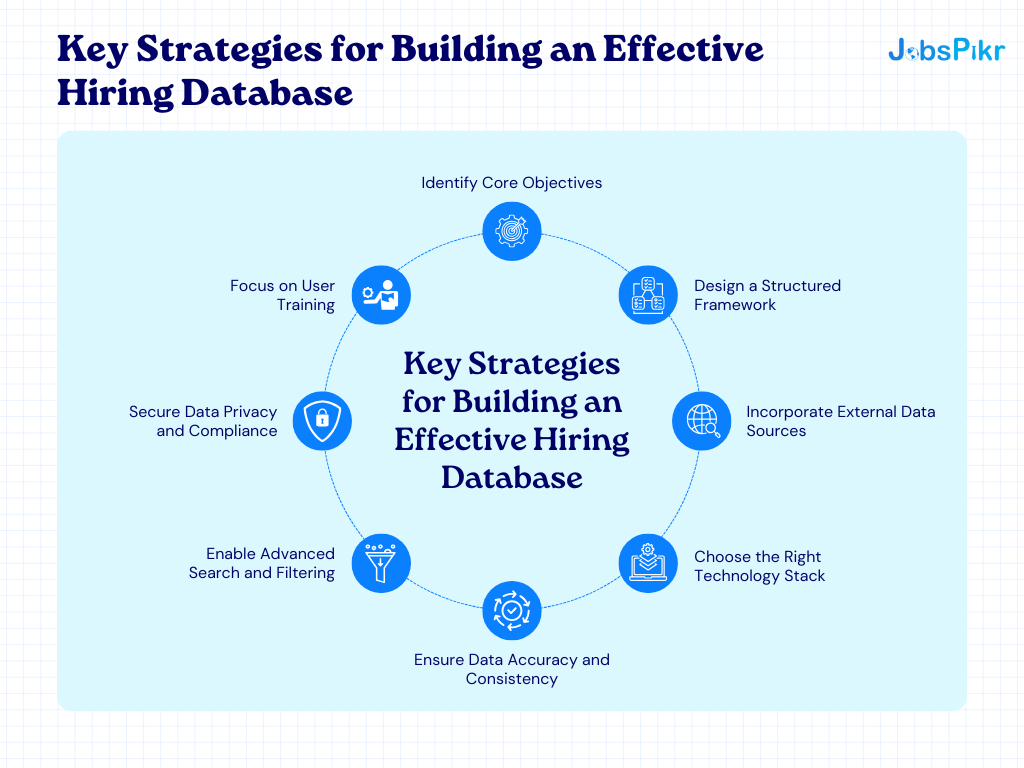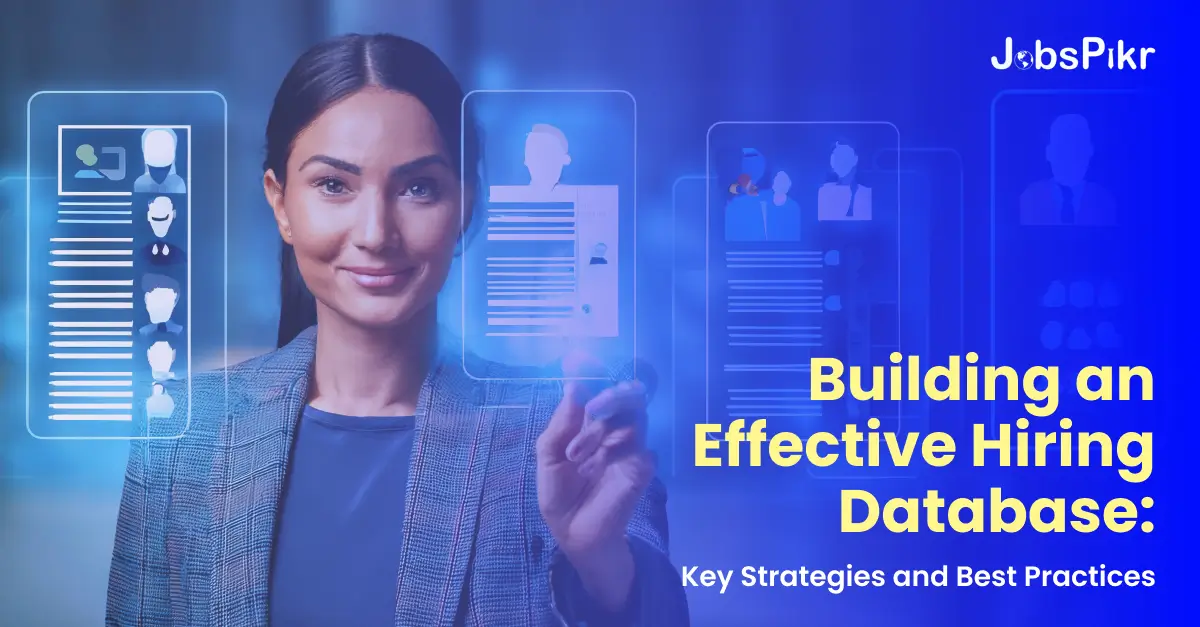Recruitment is evolving rapidly, with companies relying on data-driven approaches to find, attract, and retain the best talent. At the core of this transformation lies a hiring database—a centralized repository designed to streamline hiring processes, improve decision-making, and enhance recruitment speed.
For HR tech companies, creating and managing a robust hiring database can significantly impact how businesses scale and adapt to workforce demands. In this article, we’ll explore the importance of a hiring database, key strategies for structuring one effectively, and best practices to manage it efficiently.
What is a Hiring Database?

Image Source: PeopleManagingPeople
A hiring database is a comprehensive system that stores and organizes candidate information, such as resumes, contact details, interview notes, and evaluation scores. By centralizing this data, organizations can maintain a structured and searchable repository to streamline recruitment activities.
Unlike traditional file storage methods, a hiring database integrates market data jobs insights, enabling recruiters to make data-backed decisions, compare hiring products, and adapt strategies to dynamic labor market trends.
Why is a Hiring Database Important?

Image Source: LogicMelon
1. Centralized Candidate Information
A hiring database consolidates all candidate information into a single system, eliminating the inefficiencies of scattered documents or outdated spreadsheets. This ensures seamless access to profiles and helps recruiters retrieve information in seconds.
2. Faster Recruitment Cycles
With a searchable and well-structured job database, recruiters can quickly identify suitable candidates, reducing the time-to-hire metric. Automated workflows further accelerate repetitive tasks, like filtering applications or sending follow-ups.
3. Improved Candidate Experience
Streamlining communication through an organized system ensures no candidate is left waiting indefinitely for updates. By maintaining a structured approach, you foster trust and professionalism throughout the recruitment process.
4. Better Decision-Making
Integration with external market data jobs and analytics tools allows recruiters to benchmark salaries, assess skills availability, and predict hiring trends. This ensures hiring decisions are backed by actionable insights.
Top Strategies for Building a Successful Hiring Database

1. Identify Core Objectives
Before building a hiring database, clarify your primary goals. For instance:
- Are you focusing on high-volume hiring for multiple roles?
- Do you need to track long-term talent pipelines?
- Are you comparing hiring products to select the best tools for automation?
Understanding your objectives will help shape the database’s structure, features, and integrations.
2. Design a Structured Framework
An effective hiring database should include:
- Candidate Profiles: Resumes, skill sets, certifications, and employment history.
- Evaluation Records: Interview notes, test scores, and references.
- Job Applications: Positions applied for, application statuses, and timestamps.
- Communication Logs: Email correspondence, interview schedules, and feedback.
A structured framework ensures consistency and prevents crucial details from falling through the cracks.
3. Incorporate External Data Sources
Enhance your hiring database by integrating external sources, such as market data jobs, labor market insights, and industry benchmarks. For example:
- Job Market Trends: Use third-party APIs or tools like JobsPikr to stay updated on job demand, salary benchmarks, and skill availability.
- Competitor Analysis: Compare hiring products used by industry leaders to gain a competitive edge.
By embedding external data into your database, you create a dynamic system that adapts to real-world changes.
4. Choose the Right Technology Stack
Invest in a scalable Applicant Tracking System (ATS) or database management tool tailored to your organization’s needs. Consider factors such as:
- Integration capabilities with HR tools and job boards.
- AI-powered features for resume parsing and skill matching.
- Data security measures, including compliance with GDPR or other regulations.
Compare hiring products carefully to ensure you select a solution that aligns with your recruitment goals and budget.
5. Ensure Data Accuracy and Consistency
Outdated or inaccurate information can lead to poor hiring decisions. Regularly audit your hiring database to:
- Remove duplicate or incomplete entries.
- Update candidate information based on recent interactions or changes.
- Standardize data formats to maintain consistency across the system.
Automated validation tools can help ensure your database remains clean and reliable.
6. Enable Advanced Search and Filtering
Equip your hiring database with robust search and filtering options to quickly locate ideal candidates. Features such as Boolean search and AI-driven recommendations can significantly enhance recruiter efficiency.
For example, a recruiter searching for candidates with specific certifications and industry experience can narrow down their list in seconds, improving productivity.
7. Secure Data Privacy and Compliance
Recruitment databases handle sensitive personal information, making data security paramount. Implement strong security measures such as:
- Access Controls: Limit access based on user roles.
- Encryption: Protect candidate data during storage and transmission.
- Compliance: Align with regulations like GDPR, ensuring candidates can request data deletion or updates.
8. Focus on User Training
An advanced hiring database is only as effective as its users. Offer regular training sessions to HR teams, emphasizing:
- Database navigation and search techniques.
- Best practices for updating candidate records.
- Integrating market data jobs insights into hiring strategies.
Empowered users can unlock the full potential of your database, ensuring smoother recruitment operations.
Proven Best Practices for Optimizing Your Hiring Database
1. Regularly Update Data
Keep candidate profiles current by requesting updates during touchpoints like follow-ups or post-interview discussions.
2. Leverage Analytics for Insights
Analyze data patterns to identify hiring bottlenecks, predict future talent needs, and optimize sourcing strategies.
3. Collaborate Across Teams
Allow hiring managers, recruiters, and HR leaders to contribute to and access the database, fostering collaboration and reducing silos.
4. Track Metrics
Monitor key recruitment metrics such as time-to-hire, cost-per-hire, and candidate dropout rates to refine your hiring processes.
Conclusion
Building an effective hiring database is no longer optional—it’s essential for organizations aiming to compete in today’s talent-driven economy. A robust database not only centralizes candidate information but also empowers HR teams to make informed, data-driven decisions.
By incorporating market data jobs insights, leveraging advanced technologies, and adhering to best practices, HR tech companies can create a job database that is agile, scalable, and secure. In turn, this helps organizations attract top talent, reduce hiring costs, and stay ahead in a competitive market.Sign up on JobsPikr to integrate external market insights seamlessly into your hiring database. Let us help you build the future of recruitment today!



